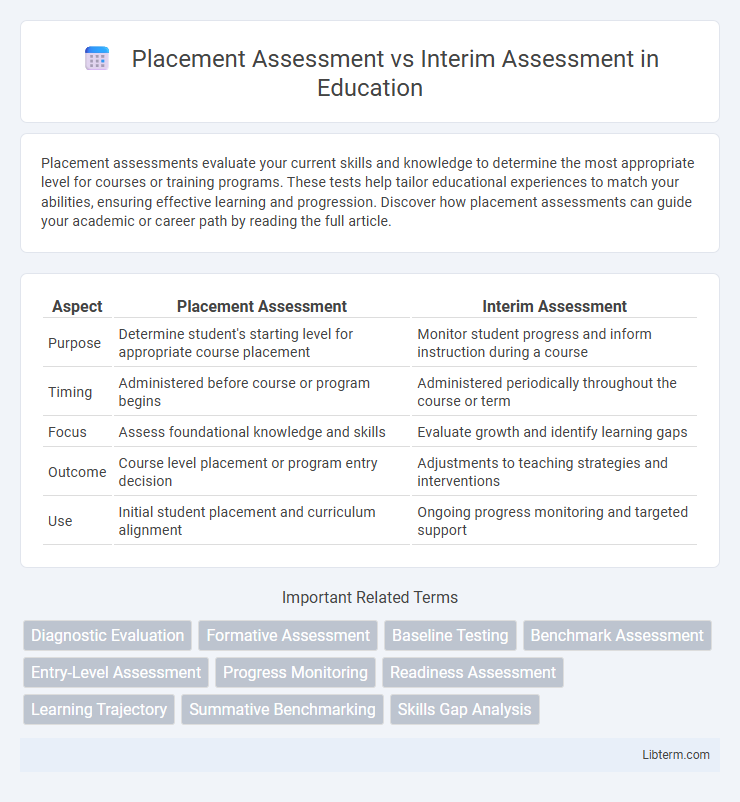Placement assessments evaluate your current skills and knowledge to determine the most appropriate level for courses or training programs. These tests help tailor educational experiences to match your abilities, ensuring effective learning and progression. Discover how placement assessments can guide your academic or career path by reading the full article.
Table of Comparison
| Aspect | Placement Assessment | Interim Assessment |
|---|---|---|
| Purpose | Determine student's starting level for appropriate course placement | Monitor student progress and inform instruction during a course |
| Timing | Administered before course or program begins | Administered periodically throughout the course or term |
| Focus | Assess foundational knowledge and skills | Evaluate growth and identify learning gaps |
| Outcome | Course level placement or program entry decision | Adjustments to teaching strategies and interventions |
| Use | Initial student placement and curriculum alignment | Ongoing progress monitoring and targeted support |
Understanding Placement Assessment
Placement assessments evaluate a student's existing knowledge and skill level to determine the appropriate starting point in a course or program, ensuring tailored instruction. These assessments use diagnostic data to place learners accurately, preventing gaps in foundational understanding. Unlike interim assessments that monitor progress during instruction, placement assessments focus primarily on initial student readiness and course alignment.
Understanding Interim Assessment
Interim assessments provide periodic evaluations throughout an academic term to monitor student progress and guide instructional adjustments, unlike placement assessments that determine the initial skill level before instruction begins. These assessments offer actionable data on student learning trends and gaps, enabling educators to tailor teaching strategies effectively. Using interim assessment results supports ongoing academic growth and enhances overall educational outcomes by addressing learning needs in real time.
Key Differences Between Placement and Interim Assessments
Placement assessments determine students' initial skill levels to assign appropriate course levels or interventions, establishing a baseline for learning. Interim assessments measure student progress during a course, providing data to adjust instruction and improve outcomes before final evaluations. Key differences lie in timing and purpose: placement assessments are used at the start, while interim assessments support ongoing instructional decisions to monitor growth.
Purposes of Placement Assessment
Placement assessments serve to accurately determine a student's current skill level and knowledge base before instruction begins, ensuring that learners are matched with appropriate course materials or levels. These assessments help educators identify individual strengths and weaknesses to tailor instruction and maximize learning outcomes. Unlike interim assessments, which monitor progress throughout a course, placement assessments focus on initial readiness to optimize educational placement.
Purposes of Interim Assessment
Interim assessments are designed to monitor student progress and inform instruction throughout the academic year, providing educators with data to adjust teaching strategies and improve learning outcomes. Unlike placement assessments that determine initial student placement, interim assessments evaluate growth by measuring knowledge and skills at multiple points, enabling timely interventions. These assessments support personalized learning by identifying gaps and tracking improvements, ensuring students stay on track toward achievement goals.
When to Use Placement Assessments
Placement assessments are best used at the beginning of a learning program to accurately determine a student's current skill level and assign them to the appropriate course or instructional group. These assessments help educators tailor instruction by identifying knowledge gaps and ensuring students start at the correct difficulty level. Using placement assessments saves time by preventing learners from repeating content they have already mastered or struggling with material beyond their capabilities.
When to Use Interim Assessments
Interim assessments are best used periodically throughout an academic term to monitor student progress and inform instructional adjustments, providing timely data to address learning gaps before final evaluations. Placement assessments occur at the start of a course or grade level to determine students' existing knowledge and skills for appropriate class placement. Employing interim assessments during the semester supports continuous improvement and targeted teaching strategies based on evolving student performance.
Impact on Student Learning and Progress
Placement assessments identify students' existing knowledge and skills, enabling tailored instruction that targets specific learning gaps from the outset. Interim assessments monitor student progress throughout the academic term, providing actionable data that informs instructional adjustments and supports timely interventions. Together, these assessments enhance student learning by ensuring instruction is both appropriately targeted and responsive to ongoing progress.
Advantages and Limitations of Each Assessment Type
Placement assessments provide accurate initial skill levels, enabling tailored instruction that aligns with student needs, but they may not capture growth over time or instructional impact. Interim assessments offer ongoing data to monitor progress and adjust teaching strategies mid-course, yet they can be time-consuming and may cause testing fatigue among students. Both assessment types support personalized learning but require strategic implementation to balance immediate placement accuracy with continuous performance evaluation.
Choosing the Right Assessment for Your Educational Goals
Placement assessments evaluate students' existing knowledge to assign appropriate starting levels, ensuring tailored instruction aligned with their proficiency. Interim assessments monitor student progress during a course, providing data to adjust teaching strategies and improve learning outcomes in real-time. Selecting the right assessment depends on whether the goal is to identify initial learning needs or to gauge ongoing academic development.
Placement Assessment Infographic

 libterm.com
libterm.com